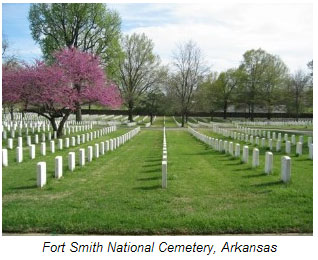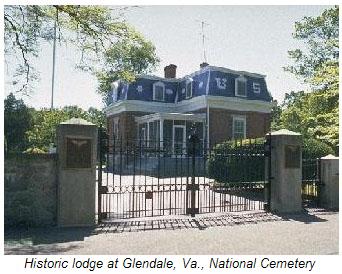General History

In the summer of 1862, George F. Root was putting the finishing touches on the words and music of the "Battle Cry of Freedom" that would be adopted as a national anthem (in different versions) by both the Union and the Confederacy. It was the second summer of a terrible war that few had believed would last more than several months. Thousands had already died at places like Wilson's Creek, Bull Run, Shiloh, and Fort Donelson.
On July 17 of that year, Congress enacted legislation that authorized the President to purchase "cemetery grounds" to be used as national cemeteries "for soldiers who shall have died in the service of the country." Fourteen cemeteries were established that first year, including one in the sleepy Maryland town of Sharpsburg where 4,476 Union soldiers were laid to rest after the one day of terrible slaughter that was the Battle of Antietam. (By way of comparison, approximately 3,000 Americans, British and Canadians died on June 6, 1944, in the invasion of Normandy).

By 1870, the remains of nearly 300,000 Union dead had been buried in 73 national cemeteries. Most of the cemeteries were located in the southeast, near the battlefields and campgrounds of the Civil War. After the war, Army crews scoured the countryside to locate the remains of soldiers who had died in battle. They were buried with honor in the new national cemeteries, which were enclosed by brick walls and entered by means of ornate gates. Tragically, however, the identities of nearly half of those who died in service to the Union and are buried in national cemeteries are unknown.

The National Cemetery Administration has evolved slowly since the initial period of great challenge associated with the Civil War. All honorably discharged veterans became eligible for burial in 1873. Cemeteries associated with military posts on the western frontier, such as Fort McPherson, Nebraska, were added to the system in the late 19th century.
In the 1930s, new national cemeteries were established to serve veterans living in major metropolitan areas such as New York, Baltimore, Minneapolis, San Diego, San Francisco, and San Antonio. Several, closely associated with battlefields such as Gettysburg, were transferred to the National Park Service because of their value in interpreting the historical significance of the battles. In 1973, Public Law 93-43 authorized the transfer of 82 national cemeteries from the Department of the Army to the Veterans Administration, now the Department of Veterans Affairs (VA). Joining with 21 VA veterans cemeteries located at hospitals and nursing homes, the National Cemetery System comprised 103 cemeteries after the transfer.

On November 11, 1998, the President signed the Veterans Programs Enhancement Act of 1998 changing the name of the National Cemetery System (NCS) to the National Cemetery Administration (NCA).
Today, there are 149 national cemeteries in all. VA, through its National Cemetery Administration, administers 135 of them. Two national Cemeteries — Arlington and Soldiers Home — are still administered by the Army. Fourteen national cemeteries are maintained by the Department of the Interior.
More than 4.1 million people, including Veterans of every war and conflict — from the Revolutionary War to the war in Iraq and Afghanistan — are honored by burial in VA's national cemeteries. More than 20,000 acres of land from Hawaii to Maine, and from Alaska to Puerto Rico are devoted to the memorialization of those who served this nation. More than 350 recipients of the Medal of Honor are buried in VA's national cemeteries.
In September 2016, VA opened its 135th cemetery — Omaha National Cemetery. Of the national cemeteries, 77 are open to all interments; 17 can accommodate cremated remains and the remains of family members for interment in the same gravesite as a previously deceased family member; and 41 will perform only interments of family members in the same gravesite as a previously deceased family member.
In addition to providing a gravesite and a graveliner, VA opens and closes the grave, provides a headstone or marker, a Presidential Memorial Certificate, a U.S. Flag, and perpetually cares for the grave at no cost to the Veteran's family.
Today, there are more than 22 million living Veterans who have earned the honor of burial in a national cemetery. Veterans with discharges other than dishonorable, their spouses and dependent children may be eligible for burial in a VA national cemetery. Those who die on active duty may also be buried in a national cemetery.







